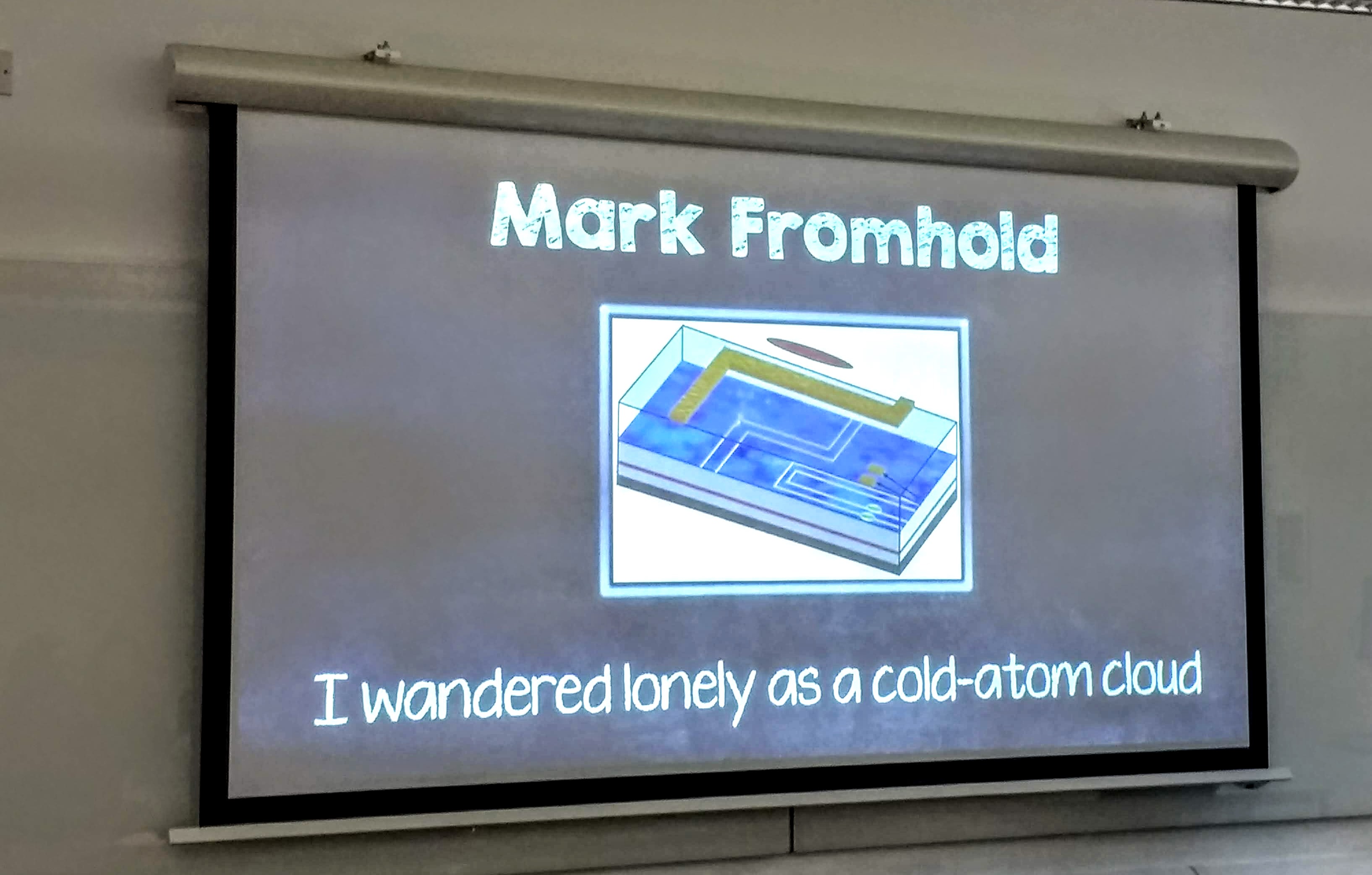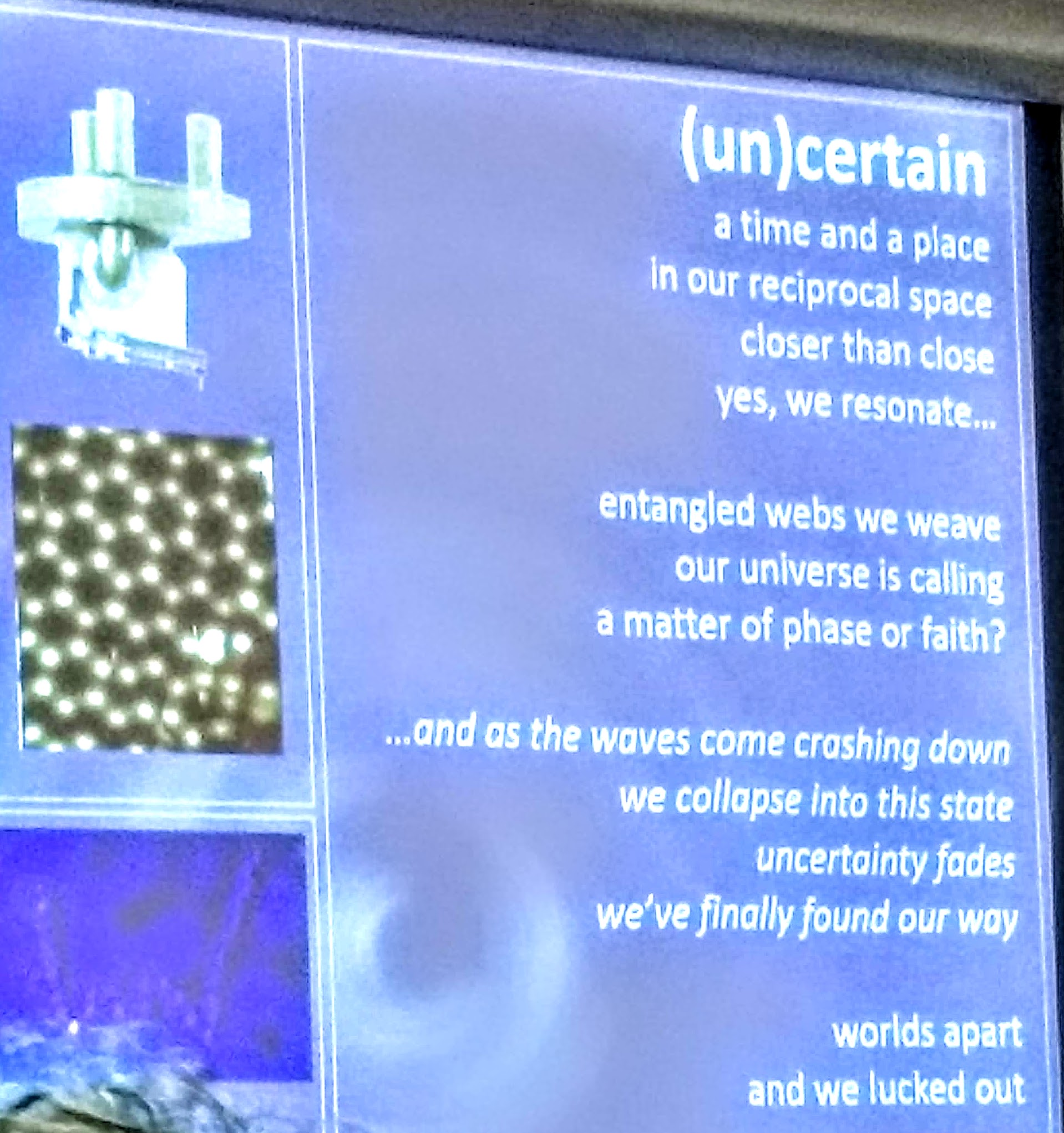
April 30, 2019, by Brigitte Nerlich
Science and poetry: Effing the ineffable
A couple of weeks ago, Phil Moriarty sent me a poem and a piece of music about (un)certainty ahead of an afternoon of science and poetry on 29 April here at the University of Nottingham.
Travelling through cultures
This made me think about science and literature, a topic of endless fascination about which countless people have written, not least the British novelist and scientist C. P. Snow, who claimed in 1959 that the humanities and the sciences were “two cultures”. This started ongoing discussions about the institutional divisions between the arts and the sciences and, also, efforts to overcome them.
Snow first wrote about ‘the two cultures’ in 1956, in an article for the New Statesman. This means that I have lived with that division all my life. For half of my life I have also been trundling forwards and backwards between two (overlapping) cultures, the British and the German one. For half of my life I have been speaking German and for the other half English. And finally, for about twenty years I have been a humanities person and for the last two decades I have become enchanted by science.
I have now got a thoroughly mingled linguistic and cultural identity, especially delighting in the work of people past and present who bring the sciences and the arts together.
Effing the ineffable
So, sitting, yet again, on a plane to Germany I thought: What do science and poetry do that make them both so exceptional that people not only think about these activities separately but also feel propelled to combine and compare them? I came to the conclusion that things are actually quite simple (they probably are not): science and poetry try to and sometimes manage to ‘eff’ the ‘ineffable’; that’s all. They make the ineffable effable.
The word ‘ineffable’ refers to something that cannot be expressed or described in language, is too great for words, transcends expression, is unspeakable, unutterable, inexpressible (see Oxford English Dictionary). While looking up ‘ineffable’, I found to my surprise that the word ‘effable’, now archaic, was used in 1668 by John Wilkins, one of the founders of the Royal Society, in his Essay towards a Real Character and a Philosophical Language. So I am in good company.
But how do scientists and artists make things ‘effable’? They do that in quite similar ways (whatever similar means here), namely by observing, thinking (which can entail hypothesising) and experimenting. Of course, experimenting might mean something quite different in science and in poetry and in various sciences and through the ages, but it’s just trying things out and seeing what works (and comparing results with existing work, genres, theories etc.). In science this process has been systematised in parts (what some call the ‘scientific method’, about which quite a few poems and even songs have been written).
Imagination and Bildung
Both in science and art, ‘effing’ relies on our imagination (Einbildungskraft), passion and enthusiasm. Imagination, not just ‘cool reason‘, makes science and art happen, in whatever shape and form, and with it culture and with that what I call Bildung, a word that resonates, at least in the German culture, with imagination (image = Bild). Both art and science ‘imagine the world’, as the title of this year’s Hay Festival proclaims.
In modern culture a huge danger looms and that is the steady erosion of the imagination and of Bildung (or, as Athene Donald wrote ‘a rounded education’) in favour of a utilitarian approach to the appliance of science and and the arts for mainly monetary ends. This contradicts the ideal of Bildung favoured by Wilhelm von Humbold, one of my favourite philosophers, linguists and education experts.
Humboldt favoured an approach to education (and, one could say, public engagement with science and the arts), based on the ideal of Bildung. For him, Bildung can only flourish under conditions that allow citizens to immerse themselves in “a manifold of situations” (eine Mannigfaltigkeit der Situationen)”. This enables them “to enter freely into relationships of association and cooperation with one another, because, Humboldt argued, humans can realize their potential as individuals only in society.” Focusing on impact or, worse still, closing down humanities and social science departments threatens such flourishing, as much as it endangers science and society.
Science Rhymes
So it’s a relief to find that this week here at the University of Nottingham, citizens, be they scientists, artists or whatever could come together to explore science and poetry on the occasion of Science Rhymes. This event was organised by Gerardo Adesso who is Professor of Mathematical Physics and writes poems for the leading physics journal Physical Review Letters (see here). It was part of the Nottingham Poetry Festival. Here is some more background about how the event came about. Here are some of the acts.
 There were poems on the complexity of the human body by a computational biologist, on the brain by a computational neuroscientist, a poem using AI and read by a machine (which was very weird), a poem on the Fibonacci sequence (entitled ‘Fib Fib’) and on interdisciplinarity, on supercold atoms, on quantum thermodynamics, a poem celebrating the invention and inventor of Ibuprofen. Some poems rhymed, some didn’t, some experimented with words and letters in ways that reminded me of Dadaism. The introduction and transitions between the performances were poetically delivered by Gerardo who was a lively and enthusiastic host.
There were poems on the complexity of the human body by a computational biologist, on the brain by a computational neuroscientist, a poem using AI and read by a machine (which was very weird), a poem on the Fibonacci sequence (entitled ‘Fib Fib’) and on interdisciplinarity, on supercold atoms, on quantum thermodynamics, a poem celebrating the invention and inventor of Ibuprofen. Some poems rhymed, some didn’t, some experimented with words and letters in ways that reminded me of Dadaism. The introduction and transitions between the performances were poetically delivered by Gerardo who was a lively and enthusiastic host.
Knowledge and metaphors
This all made me think about metaphors. What struck me was that science poems are like metaphors. You can only understand them if you know stuff about, or have experience of, the source domain. Metaphors map ‘knowledge’ from a source domain (say, war) onto a target domain (say, illness), a process that then produces utterances like “I am still fighting off the flu”. Normally, our everyday knowledge of the world allows us to understand such metaphors. There are limits to understanding, however, which are set by knowledge shared or not between the speaker and the hearer (this becomes more extreme when one of the interlocutors, an expert, knows more about something or has detailed knowledge of very different things).
I once used the following metaphor in talk I gave in Germany: “This is pop tart philosophy”. My muesli-eating audience did not ‘get’ it. They had never eaten a ‘pop tart’ (not something that I would recommend). Some told me afterwards that I should not have used the word ‘tart’….
I felt a bit like the non-pop-tart eaters when listening to some of the science poems. I got the rhymes and the rhythms, the world play and the puns, but I sometimes didn’t quite understand the whole, as I lacked detailed knowledge of, say, the Fibonacci sequence. However, poems dealing with human experience of science were more easy to decode, such as this one by Gerardo Adesso:
“Trabalho e Calor (Work & Heat):
Quantum Thermodynamics is the science
Of work, heat, and energy exchange
At very small scales
Where the laws of classical physics break down
Like social inhibitions
In a group of scientists with free-flowing beer […]”
This does not mean that metaphors and poems are not important. They absolutely are – and the audience with their expert knowledge enjoyed them all.
I’ll end with a quote from a great article on science and poetry by Ruth Padel, which makes one of the most important points about science and poetry: “poetry and science have more in common than revealing secrets. Both depend on metaphor, which is as crucial to scientific discovery as it is to lyric. A new metaphor is a new mapping of the world. Even maths uses metaphor; and this is where more condensed forms of poetry join in.”
Science and poetry imagine and map our worlds. They make worlds; they make us; and we make them. Poems also bring people together across the world, as expressed in this quantum love song by Phil Moriarty.
No comments yet, fill out a comment to be the first


Leave a Reply